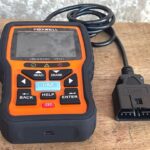The 1992 Honda Prelude uses the OBD1 system. This is a common question among Honda enthusiasts, especially those modifying or troubleshooting their vehicles. While the transition to OBD2 happened in the mid-90s, there’s often confusion about specific model years. This article clarifies the OBD system used in the 1992 Prelude and provides ways to distinguish between OBD1 and OBD2 systems in general.
Identifying OBD Systems in Honda Preludes
There are several ways to determine if a Honda Prelude, or any car for that matter, is OBD1 or OBD2:
1. Model Year: A simple rule of thumb for Honda vehicles is that models from 1992-1995 are typically OBD1, while 1996 and later models are OBD2. Therefore, a 1992 Prelude is definitively OBD1.
2. Diagnostic Port Location: OBD2 vehicles have a standardized 16-pin diagnostic port usually located under the dashboard, often near the steering column or ashtray. OBD1 systems, on the other hand, utilize various connectors often found under the hood or in less accessible locations. For the 92-95 Honda Preludes, the diagnostic port is located under a flap in the center console storage area.
3. Distributor Wiring: Examining the distributor wiring harness is a more technical method. OBD1 distributors typically have an oval connector with 8 wires. OBD2 distributors use a square connector with only 4 wires.
4. Distributor Mounting Bolts: The bolt holes on the distributor housing also offer a clue. OBD1 distributors typically have all oval mounting holes, while OBD2 distributors have two oval holes at the top and a circular hole at the bottom.
5. Internal Distributor Components: Removing the distributor cap reveals further differences. OBD1 distributors often have a sensor located directly beneath the rotor, resembling a black box. This sensor is typically absent in OBD2 distributors.
6. MAP Sensor Location: In 92-95 (OBD1) Preludes, the Manifold Absolute Pressure (MAP) sensor is located on the firewall. In 96 and later (OBD2) Preludes, the MAP sensor is mounted on the throttle body.
7. Wiring Harness Connectors: OBD2 Preludes have an extra connector near the main engine wiring harness connector (often a large blue plug) that is not present on OBD1 harnesses.
8. Distributor Shaft Rotation: This is a less common method, but rotating the distributor shaft can indicate the OBD system. OBD1 distributors typically click with each small rotation, while OBD2 distributors click after a half turn. OBD2 distributors are also generally lighter than their OBD1 counterparts.
Why OBD Matters: Tuning and Modifications
Understanding the difference between OBD1 and OBD2 is crucial for engine tuning and modifications. OBD1 systems are often favored for tuning due to their relative simplicity. They primarily monitor essential engine parameters, making them easier to modify for performance enhancements. OBD2 systems, while more comprehensive in their monitoring, can be more challenging to tune due to their complexity. Historically, readily available tuning solutions were more common for OBD1 systems. This made converting later model vehicles to OBD1 a popular practice among enthusiasts.
Conclusion
In summary, a 1992 Honda Prelude is equipped with an OBD1 system. This can be confirmed through various methods, including checking the model year, diagnostic port location, and examining the distributor. The differences between OBD1 and OBD2 extend beyond simple diagnostics, impacting tuning capabilities and modifications. Recognizing these distinctions is vital for anyone working on or modifying older Honda vehicles.

